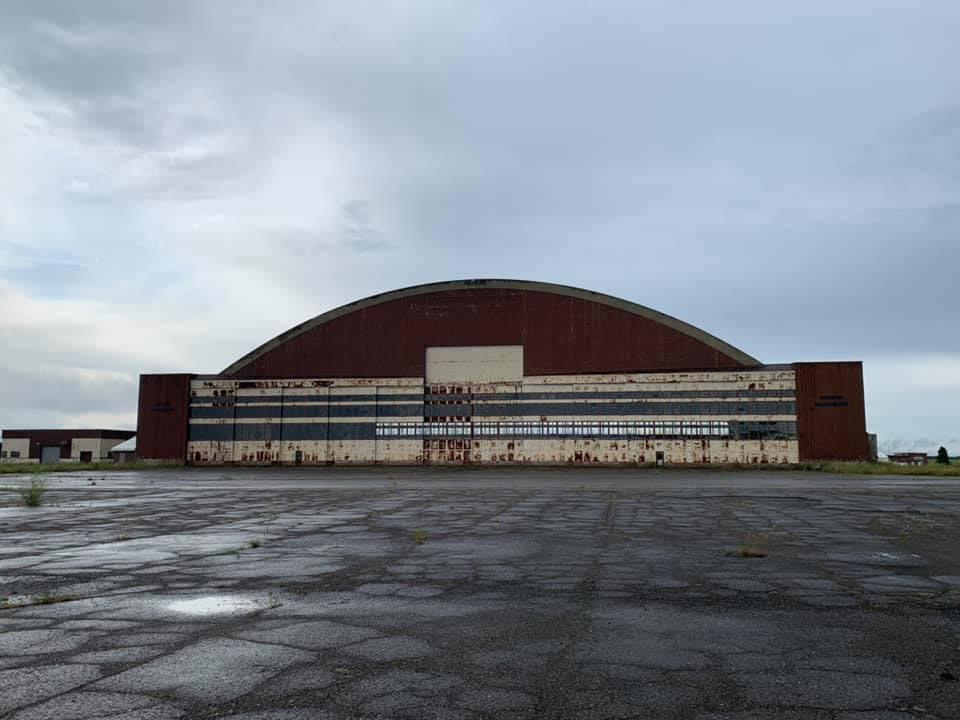
LIMESTONE, Maine – Maine developers who have purchased part of the former Loring Air Force Base warned legislators Tuesday that allowing a local museum to own the famous “arch hangar” would destroy any chance of redeveloping the base’s airport.
In 2023, Portland-based Green 4 Maine purchased 450 acres from Loring Development Authority, an entity the Legislature created over 30 years ago to redevelop Loring into an industrial and aviation hub. Green 4 Maine announced last summer that HyperSpace Propulsion, also based in Portland, intends to assemble and test its low-orbit “spaceplane” at the Loring airport and bring an economic boost to Aroostook County.
HyperSpace Propulsion wants the arch hangar for production space.
Sponsored by Sen. Troy Jackson, D-Allagash, legislative bill LD 1998 would transfer ownership of the arch hangar to Loring Air Museum, which wants to designate the building as a historic property and relocate the museum in the structure. The huge hangar housed aircraft and weapons at the height of the Cold War. With little activity at the hangar in 30 years, volunteers said they want to see the building’s history preserved.
Developers and museum proponents laid out their opposing visions for the hangar to the Legislature’s Committee on Innovation, Development, Economic Advancement and Business during a hearing on the bill at the State House in Augusta.
Losing the arch hangar would mean no location for HyperSpace’s operations and no chance that the airport would receive Federal Aviation Administration funding for upgrades, said Scott Hinkel, Green 4 Maine’s president.
“Loring is developing a master plan for the airport. Without the arch hangar, there is no reason for the FAA to invest,” Hinkel said.
HyperSpace CEO Richard Lugg was unable to speak during Tuesday’s hearing but provided written testimony. Lugg stated his company plans to invest over $4.7 billion within the next three years to jumpstart its operations, which includes renovating the arch hangar starting in spring 2024.
Founded in 2018, HyperSpace wants to turn the arch hangar into a production facility and Loring’s runways into testing sites for its SPACESTAR, a plane powered by rocket engines that could enter low-orbit outer space and transport cargo and passengers faster than typical planes.
HyperSpace wants to begin manufacturing its SPACESTAR by 2026 with $847 million from NASA’s Space Launch Program and a U.S. Hypersonic Strike Package, a $1.3 billion sea and airborne hypersonic missile system, for the United States Navy, Lugg said in his testimony.
“These aerospace programs will bring over 1,000 professional, technical and managerial jobs,” Lugg said. “With forecasted revenue of $6.7 billion by 2028.”
Through a 5-year agreement between Loring Development Authority and Green 4 Maine, the authority will maintain ownership of the Loring Airfield because airports need to have state or municipal-based owners to qualify for FAA funding. The authority, per state statute, is considered a “public municipal corporation.”
But though Green 4 Maine does not want to own the airport or hangar, it does hope to purchase more Loring land if it meets certain benchmarks, like creating at least 75 permanent jobs, Hinkel said. Signing on companies like HyperSpace is crucial to Green 4 Maine’s ability to attract more companies to Loring.
Matt Cole, vice president of the Loring Air Museum, said that the hangar’s arched roof has begun to leak, which could cause water damage if the problem worsens. With designation from the National Register of Historic Places, the museum would be eligible for state and federal funds to restore the hangar.
With little done to maintain the arch hangar in the past 30 years, Cole said he and museum volunteers want to make sure someone preserves the building.
“I’d say we have a year maximum before something catastrophic happens,” Cole said. “We really don’t want to see this building get torn down.”
Hinkel said that there are no plans to tear down the arch hangar due to HyperSpace’s intentions to use the space.
Jackson also spoke of the lack of redevelopment at both the hangar and airport. After speaking with Loring Development Authority and Green 4 Maine, he still supported the bill because of local residents’ support for doing something tangible with the space.
If the Legislature does not support transferring the hangar to Loring Air Museum, Jackson said he would support the Legislature allocating funds toward repairs or rewrite LD 1998 in a way that allows both the museum and a commercial entity to use the space.
“If there’s a business that can use the space, that’s what I’m hoping for,” Jackson said. “We just want to make sure this building gets restored.”
Steve Dobson, a board member of Aroostook County Tourism and Jacob Pelkey, tourism coordinator for Aroostook County Tourism also spoke in favor of LD 1998 because of the hangar’s potential to attract tourists.
The arch hangar attracts 5,000 to 6,000 snowmobilers every year who want their pictures taken in front of it, Dobson said. Many former service members and community members also enjoy visiting the museum and the sites of former storage areas for hydrogen and nuclear weapons.
Over 4,000 to 6,000 people visit Loring Air Museum every summer, with the number rising to around 12,000 in years when the museum holds an open house, Cole said.
“These people all come through word of mouth. Think of how many people we could attract with a more coordinated promotion,” Dobson said.
LD 1998 will be subject to work sessions in the Committee on Innovation, Development, Economic Advancement and Business before being voted on in the Legislature.







